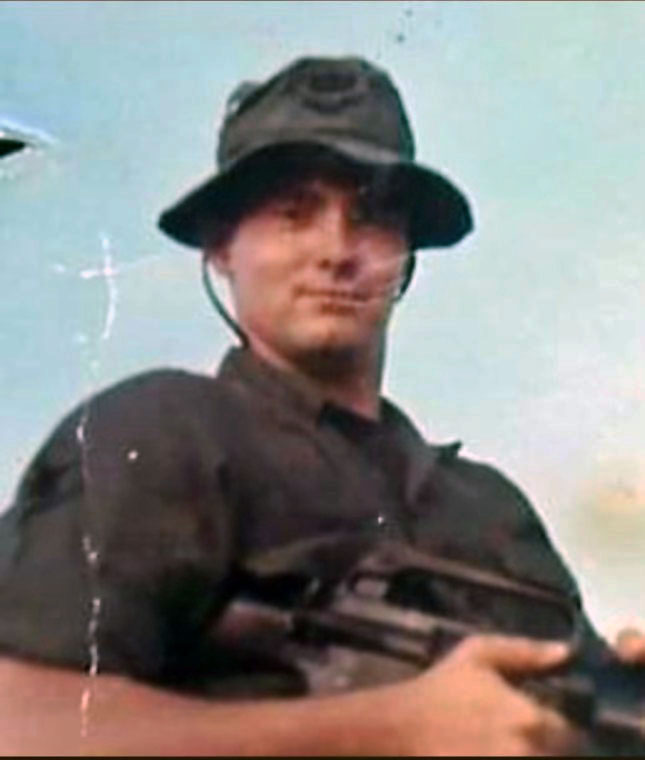Specialist-4 Richard Sanders
“Chopper Down” Rescue Service in Vietnam
by Richard D. L. Fulton
Helicopters played a major role in the Vietnam War, notably in support of ground operations and in airlifting combat casualties, but this placed many of them at the risk of taking enemy fire themselves.
Richard Sanders, Sabillasville, was born in 1947 in the Waynesboro Hospital, the son of parents Lester and Hilda Sanders of Sabillasville. His father, Lestor, worked as a pipe cutter in a pipe factory, according to the 1950 United States Federal Census, while his mother was listed as a housewife.
Sanders attended Thurmont High School, graduating in 1965, and attended Penn State Mont Alto, graduating in 1968 with an “accelerated” associate degree in engineering technology.
The course was “accelerated” as the result of Sanders having been serving in the Pennsylvania Army Reserve since 1966 with the 357th Transportation Company based in Hagerstown. Facing activation with his unit as the Vietnam War continued to drag on, Penn State Mont Alto staff and professors accelerated the final courses and final exams needed to satisfy the requirements of earning the associate degree.
Following the May 1968 activation of the 357th Transportation Company, Sanders, as a helicopter crew chief, and the 357th Transportation Company (classified as Aircraft Maintenance Direct Support) were assigned to Fort Benning, Georgia for advance training before being shipped overseas to Vietnam. The advance elements of the 357th arrived at Bien Hoa Air Base on September 27, 1968 followed by the main body on October 11.
The 357th Transportation Company was assigned to the 520th Transportation Battalion, with a portion of the 357th designated as the 20th Transportation Company, which was then based at Cu Chi. Sanders was then with the 20th Transportation Company because of the re-designation. The primary helicopter of the transportation units was the “Huey.”
As to the duties of Sanders and the 20th Transportation Company, they were to repair battle-damaged helicopters and render them serviceable.
He said repair work restoring downed helicopters was accomplished by the men in shifts, but if one or more of the workers was making substantive progress on one of the wrecks, they might not cease work on the craft until it was fully functional again.
“If you started working on one (damaged helicopter), you worked on it until it could get back into the air again,” Sanders said.
It would seem that such a job would not entail much of a risk, but the base had come under attack several times. In February 1969, a small force of the Viet Cong attacked Cu Chi and damaged and destroyed 11 aircraft, according to transportation.army.mil. The base was again attacked on August 15, resulting in the 20th Transportation Company having sustained a number of wounded.
Another of Sanders’ duties was to serve on recovery helicopters as needed to bring back downed choppers, which often entailed flying into active combat zones, Sanders explained, noting, “Everyone took turns flying (on recovery missions).”
Sanders said the recovery operations included utilizing heavy-lift helicopters, such as the dual-propellered Boeing CH-47 Chinook and the CH54 “flying cranes” (for jobs too big for the Chinooks to handle). Recovery of a downed aircraft usually included strapping the damaged craft to the recovery helicopter and air-lifting the wreck back to the base of operations for repairs (if the helicopter was salvageable).
Encounters with the enemy were not uncommon. Sanders said when the enemy began shooting at the rescue helicopters, the crew just quickly adopted a “spray and pray” strategy: “We just opened fire and shot the hell back.”
However, Sanders was seriously wounded when a Vietcong round made a direct hit on a recovery helicopter in which he was riding. The rescue helicopter had just been rigged to a downed helicopter and was about to lift it when the round had struck.
Sanders said he didn’t know if he was hit by shrapnel or metal fragments from his helicopter, “but I caught it right in the (buttocks)…” He said the injury “looked like a checkerboard” on his behind. He was transported back to the States for hospitalization, and then released, thereby ending his career in the Army.
By the end of the war, Sanders had received the Purple Heart for his wounding, along with the unit citations awarded to all the members of the 357th Transportation Company, including the Republic of Vietnam Cross of Gallantry with Palm, the Meritorious Unit Commendation, and the Army Commendation Medal.
Sanders went on to work for Landis Tool Company (Waynesboro) for 55 years, having retired in 2020. Upon his return to the States, he had also earned two master’s degrees while in England (while employed by Landis Tool).

Richard Sanders in Vietnam.

